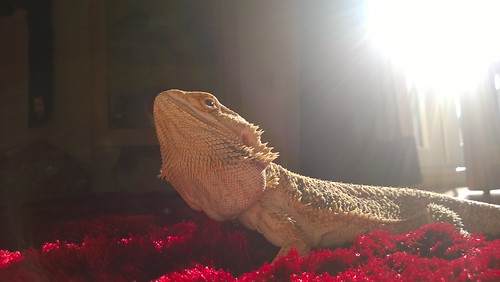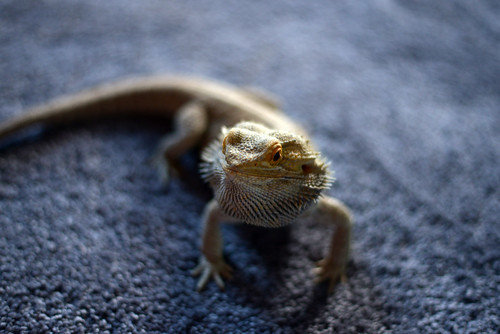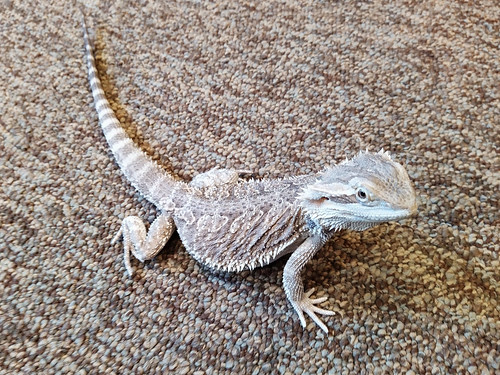Reptile carpet, also known as terrarium liner or cage carpet, is a type of substrate made specifically for reptiles.
It’s made of a soft, absorbent material that mimics natural terrain and provides a comfortable surface for your bearded dragon to move around on. Reptile carpet is typically made of a durable material that can be easily cleaned and reused.
When compared to loose substrates like sand or wood shavings, reptile carpet offers several advantages, including a lower risk of impaction and fewer hiding spots for parasites.
On the other hand, reptile carpet may not provide the same level of natural enrichment as loose substrates or bioactive setups.
Benefits of Reptile Carpet for Bearded Dragons
Here are some reasons why reptile carpet can be a cozy haven for your bearded dragon:
1. Comfortable Surface
Bearded dragons spend a lot of time on their stomachs, so it’s important to provide a comfortable surface for them to move around on. The reptile carpet is soft and cushioned, which can help reduce the risk of foot injuries and provide a cozy surface for your bearded dragon to rest on.
2. Easy to Clean
One of the biggest benefits of reptile carpet is that it’s easy to clean. Unlike sand or gravel, which can be difficult to clean and can harbor bacteria, reptile carpet can be easily removed from the enclosure and cleaned with soap and water. This can help reduce the risk of infections and ensure that your bearded dragon’s habitat stays healthy.
3. Cost-effective
Reptile carpet is a cost-effective substrate option for your bearded dragon. While it might be more expensive upfront than sand or gravel, it can be reused multiple times and doesn’t need to be replaced as often. This can save you money in the long run and ensure that your bearded dragon’s habitat stays comfortable and healthy.
4. Easy to Replace
Over time, reptile carpet can become worn or stained. However, replacing it is easy and affordable. Simply remove the old carpet and replace it with a new one. This can help ensure that your bearded dragon’s habitat stays clean and comfortable.
How to Use Reptile Carpet for Your Bearded Dragon?
Here are some tips for using reptile carpet in your bearded dragon’s habitat:
1. Choose the Right Size
When choosing reptile carpet for your bearded dragon, make sure to choose the right size. The carpet should be large enough to cover the entire bottom of the enclosure and provide a comfortable surface for your bearded dragon to move around on.
2. Clean Regularly
To keep your bearded dragon’s habitat healthy, it’s important to clean the reptile carpet regularly. Remove any waste or debris and clean the carpet with soap and water. Make sure to replace the carpet every few months or as needed.
3. Provide a Basking Spot
Bearded dragons need a basking spot in their enclosure to regulate their body temperature. Make sure to place a heat lamp or other heat source over the reptile carpet to provide a warm basking spot for your bearded dragon.
4. Monitor for Signs of Illness
Even with proper care, bearded dragons can still get sick. Monitor your bearded dragon’s behavior and appearance for signs of illness, such as lethargy, loss of appetite, or abnormal bowel movements. If you notice any signs of illness, contact a veterinarian who specializes in reptiles.
Cost and Availability
Reptile carpet generally has a higher upfront cost than loose substrates such as sand or wood shavings. However, its longer lifespan and lower risk of impaction can make it a more cost-effective option in the long run.
Popular brands and where to buy
There are several popular brands of reptile carpet available, such as Zilla, Exo Terra, and Zoo Med. These products can be found at most pet stores, as well as online retailers like Amazon, Chewy, and specialist reptile supply websites.
DIY reptile carpet alternatives
Some reptile enthusiasts opt for DIY reptile carpet alternatives, such as using indoor/outdoor carpeting or shelf liner. If considering this option, ensure the material is non-toxic, non-abrasive, and easy to clean.
Expert Opinions
Many reptile veterinarians recommend reptile carpets as a safe and suitable substrate for bearded dragons, particularly for those who are prone to impaction or have a history of digestive issues.
Bearded dragon breeders’ perspectives
Breeders may have varying opinions on the best substrate for bearded dragons. Some prefer reptile carpet due to its low risk of impaction, while others may prioritize the enrichment provided by loose substrates or bioactive setups.
Pet store advice
Pet stores often stock a wide range of substrate options, and staff may have varying opinions on the best choice for bearded dragons. It is essential to consider the specific needs and preferences of your bearded dragon when making a decision.
Transitioning to Reptile Carpet
When transitioning your bearded dragon to reptile carpet, give them time to adjust to the new substrate. Monitor their behavior closely and ensure they are comfortable and active in their new environment.
Monitoring and troubleshooting
During the transition period, keep an eye out for any signs of stress or discomfort in your bearded dragon. If issues arise, consult a reptile veterinarian or experienced bearded dragon owner for guidance.
When to switch back to other substrates
If your bearded dragon does not adapt well to reptile carpet or if you notice any negative effects on their health or well-being, consider trying an alternative substrate such as a loose substrate or bioactive setup.
Conclusion
Reptile carpet can be a cozy haven for your bearded dragon. It provides a comfortable surface for your bearded dragon to move around on, is easy to clean, cost-effective, and easy to replace. By following the tips outlined in this article, you can ensure that your bearded dragon’s habitat stays healthy and comfortable.
Frequently Asked Questions
Can reptile carpet cause impaction?
Reptile carpet is considered a low-risk substrate for impaction, as bearded dragons are unlikely to ingest the fibers. This makes it a safer option compared to loose substrates like sand.
How often should I replace my reptile carpet?
It is recommended to replace reptile carpet every three to six months, or sooner if it becomes damaged or excessively soiled.
Can I use other types of carpet for my bearded dragon?
While some reptile owners opt for DIY alternatives like indoor/outdoor carpeting or shelf liner, ensure the material is non-toxic, non-abrasive, and easy to clean before using it in your bearded dragon’s enclosure.
Is it safe for baby bearded dragons?
Reptile carpet is considered safe for both juvenile and adult bearded dragons, as it poses a low risk of impaction and provides stable footing.
Can I mix the reptile carpet with other substrates?
While some owners may choose to mix reptile carpets with other substrates for added enrichment, it is important to monitor your bearded dragon closely to ensure they do not ingest any loose substrate particles, which could lead to impaction.






Leave a Reply